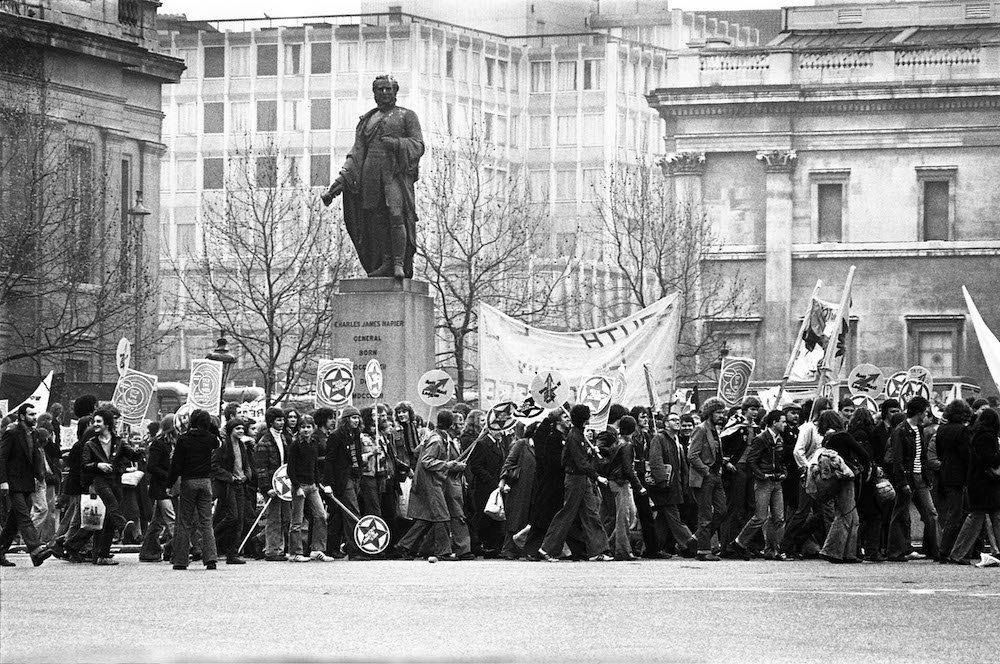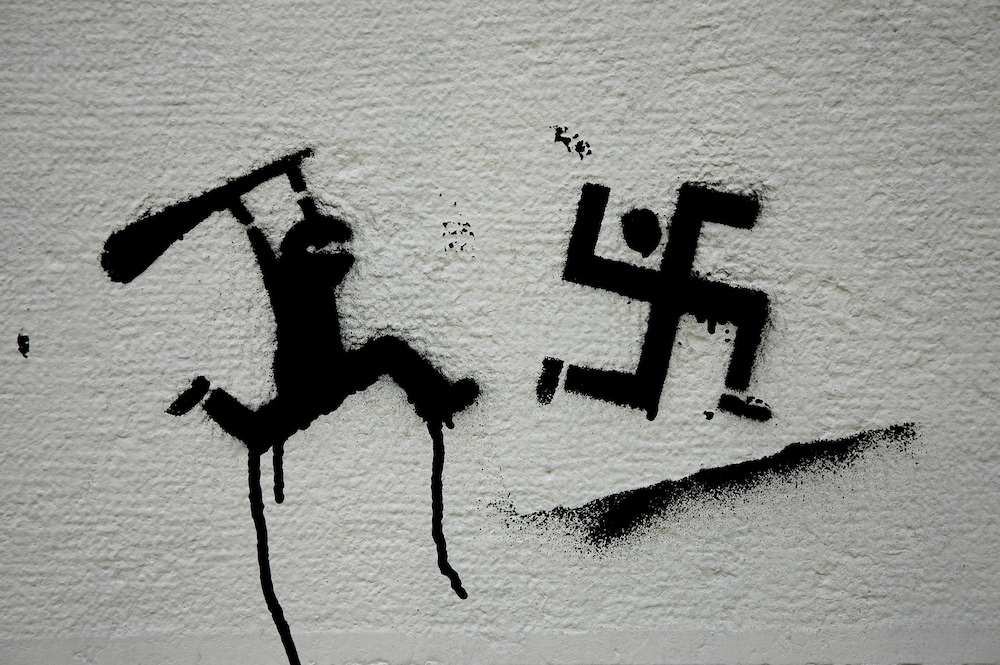The real threat to our democratic rights
Review of No Free Speech for Fascists

No Free Speech for Fascists
Exploring ‘No Platform’ in History, Law, and Politics
by David Renton
Routledge, 2021

Leftists have watched with increasing alarm the resurgence of far-right politics worldwide in recent years. From far-right parties achieving electoral gains and national-chauvinists winning power (e.g., Modi, Netanyahu, Orbán, Putin, Bolsonaro, Trump) to right-wing militias menacing streets and racists unleashing stochastic terror on racial/ethnic “others,” many have feared a renewal of fascism in our time. Here in the U.S., the far-right fringe has achieved a disturbing toehold in popular politics as both a radical flank of the mainstream conservative movement and a violent menace to our communities, campuses, workplaces, neighborhoods, and gathering places. This occurs alongside the daily symbolic and actual violence of capitalist exploitation and structural oppression by corporate and state institutions.
Similar to the rise of fascism in the early twentieth century in Europe, this resurgence is the result of economic crisis and political instability that have immiserated more layers of our society, while increasing the misery of those already on the bottom. Yet there is much that distinguishes the current moment from that of fascism’s original emergence, requiring anti-fascists and other leftists to think deeply about the strategies and tactics we must use to prevent fascism from ever coming to power again.
This need has prompted vigorous debates about the nature of fascism in relation to the broader far-right resurgence, economic instability and anxiety, institutions of authority, and—importantly—deeply held values like free speech. To all these debates, David Renton’s book No Free Speech for Fascists: Exploring ‘No Platform’ in History, Law, and Politics makes a valuable practical contribution that begins with the seemingly simple question of whether fascists should be allowed to speak. He begins on page one with a familiar scenario:
The leaders of a political party share with interwar fascism a taste for violence, an insistence that the nation is under threat and that their country can only be restored to greatness if democracy is limited and the party’s many critics silenced. One of those leaders has been offered a platform: a chance to give a televised talk, or an election meeting, or a lecture at a university. Anti-fascists insist that if the fascist is permitted to speak the rights of everyone else will be diminished. They call on the organizers to rescind the fascist’s invitation to speak. Are the anti-fascists correct to demand that the fascist meeting be canceled?
In order to answer this question, Renton offers a specifically defined tactic of “no platform.” Over three sections dedicated to the history (in Europe, the U.K., and the U.S.) of free speech and censorship, the law in relation to speech and its restriction, and the politics of preventing fascists from speaking, he presents arguments about free speech and fascism that uphold the Left’s traditional defense of the broadest freedom of expression, while justifying the denial of that freedom to fascists. He distinguishes between no platform as a specific answer to the question of fascist organizing developed in Britain in the 1970s and related approaches such as “deplatforming” and legal/administrative restrictions on hate speech. There are two key differences: First, no platform is intended to deny fascists—and fascists only—the opportunity to speak. Second, the agent of enforcing no platform can only be an insurgent people (workers, students, and the oppressed). In Renton’s view, the other approaches founder on juridical abstractions and the mirrored applicability of equal rights law on the one hand, and overly broad application by the Left on the other. By contrast, no platform, applied appropriately, can be an effective means to prevent fascist organizing and defend ourselves against local violence in the short term and against mass violence should fascists take the reins of power.
In the first section of the book, Renton sets the stage by describing the Left’s historical role of championing maximal freedom of speech and expression, and the Right’s customary position of advocating for censorship and suppression. Chapter Two presents a broad survey of important moments in the history of free speech in the West, from anti-monarchist poet John Milton’s opposition to censorship in the seventeenth century, to reactionary Edmund Burke’s support for criminalizing dissent in the eighteenth century, to revolutions in the nineteenth century, and class war in the twentieth century. Here, Renton also calls into question the conventional wisdom that the U.S. has been a bastion of free expression and its highest courts the champions of the First Amendment. On the contrary, U.S. courts in the twentieth century, “chose, while limiting speech as tightly as they could, to couch their decisions in a language of virtuous commitment to liberal principles.” This is demonstrated by key legal cases in 1919 and 1927 that despite being taken as spirited defenses of free speech, ended in upholding punishments of anti-war and pro-communist speech. Renton makes an important point in this survey, namely that fascism is unique in that its censorship of speech comes alongside violent suppression and elimination of its enemies and opponents. Yet censorship and suppression are not exclusive to fascism, but part and parcel of the politics of the Right. The current textbook wars in Texas and the nationwide right-wing moral panic around honest historical descriptions of racism in schools are hardly new; one need only look at McCarthyism in the U.S. and twentieth-century bans of books honestly portraying the system, to name some precedents.
The sole exception to the left’s commitment to the broadest possible freedom of expression, as we learn in Chapter Three, is fascism. Here, Renton details anti-fascist organizing in Britain in the 1930s and 1940s, when the urgent task was to prevent fascists from gaining recruits and coming to power as they had in continental Europe. Until 1940, that task was undertaken primarily by workers, migrants, and students, rather than employers or agents of the state. A highlight of popular anti-fascist organizing in the 1940s was the work of the 43 Group, a few hundred young Jews, many veterans of WWII, whose method of no platform was “to form its members into what was termed a flying wedge, a group of about fifteen people who would charge a fascist speaking platform, knocking it over and sending the speaker flying”( 46). They combined this with intelligence gathering, constant harassment, and confrontation, including physical violence. They largely succeeded over the course of a few years in closing every possible avenue for the fascists to speak and attract recruits, well before the government began to take action to suppress British fascist organizations.
With that history as a foundation, in Chapter Four, Renton describes the development of no platform as a specific strategy in response to a resurgence of far-right and fascist groups in the 1970s. Much like today, 1970s Britain was beset by an economic crisis, political polarization, international migration, and increasing immiseration of living standards. The key debates over no platform involved deciding both to whom the ban should be applied (fascist organizations alone, fascist and racist organizations, individual fascists and/or racists, or agents of the state), who should apply and enforce it, and what such a ban would entail (disinvitation, protest, or outright banning). Such debates are still with us, as anti-fascists and anti-racists in the streets and on campuses work out how to respond when a fascist or other bigot seeks a platform. However, American campuses lack the same mass organizations of students with the same kinds of agency over how their resources are to be used, and parallel efforts like those of the U.K.’s Anti-Nazi League and Rock Against Racism (both described in Renton’s book Never Again) have not succeeded in forming in the U.S. The important point of this history is that “no platform was an approach which came from below, not above; it required no politician, no judge, and no social media platform to implement it. The plan was to encourage popular control and increase speech, rather than limiting it” (52).

Given the similarities in economic and political circumstances between the U.K. and the U.S. in the 1970s, it is important to consider why no platform did not develop as a tactic in the U.S., a question Renton takes up in Chapter Five. When faced with fascist organizing in two key moments, opponents of fascism in the U.S. took two different paths. One was to seek to limit fascist speech and assembly from above (government, employers, and the media). Another was to pursue affinity organizing and demonstrations of radicalism rather than building alliances and gathering larger forces to stop fascists from organizing. Renton describes the limits of both and emphasizes the need for communities to self-organize, and to do so as broadly and popularly as possible in order to deny fascism room to recruit and grow.
Renton concludes the first section of Chapter Six by detailing a pivotal development in the growth of fascism and the far-right worldwide: they have successfully taken up the banner of free speech while much of the left has found itself increasingly reliant on law, government, and business to restrict fascist speech from above. He charts the rise of the Front National (FN) in France from a fringe element to a significant force in European politics and discusses how the outsider strategy of the FN has been used by other far-right groups successfully across Europe, and in the U.K. and U.S. The process is similar in many countries: the fascists first seek to dust off the most explicit trappings of their fascist past from their public countenance, then they use the principles of free speech and inclusion (taken from the Left) to gain access to audiences with establishment support and enter mainstream politics. In this way, the far-right has become a radical flank of the mainstream Right, pulling ever rightward. The result has been a significant breakthrough of fascists and other reactionaries into electoral politics and mainstream political discourse, where their influence has underwritten waves of anti-migrant, sexist, Islamophobic, and other projects, with disastrous consequences for millions.
The second section of the book is dedicated to a discussion of the legal treatment of speech and its curtailment in Europe and the U.S. Here, Renton distinguishes no platform from the prohibition of hate speech. In Chapter Seven, he takes up arguments in favor of restricting hate speech (put forth by Jeremy Waldron, among others), and suggests that those who would legally ban hate speech appear to accept the bargain of greater state power to restrict free expression in order to prevent hate speech from furthering its harms against the oppressed. Yet, as Renton argues in Chapters Eight and Nine, anti-hate speech campaigners’ appeals to the law and the state have two very negative consequences for a Left interested in defending and increasing the broadest possible freedom of speech for all (except fascists). The first is the misplaced faith in institutions to act as neutral or benign arbiters, institutions already involved and invested in the maintenance of exploitation and oppression. The second is the transformation of anti-racists and anti-fascists “from insurgents into petitioners,” ceding the necessary terrain of political struggle to authorities and the courts (92). By contrast, no platform “sees the state as an agent in a three-sided conflict, with fascists on one side, anti-fascists on the other and the police fighting assiduously in their own interests (with the press, the judiciary, etc., no distance behind” (123).
The risks inherent in seeking help from above are no less when the authority in question is a social media platform or employer, as Renton describes in Chapter Ten, opening the third section of the book. No platform, he argues, is different from deplatforming, which “actually means lobbying social media companies to shut down far-right pages” where “the agents of change turn out to be huge platforms and the businesses…who buy advertising space from them” (123). As with the law, the platforms and businesses that only recently have begun to ban fascist content have only under tremendous popular pressure halted the very same content they enabled to spread so widely in the previous decade, with algorithms geared towards arousal and outrage in service of their profits. As with authorities and the courts, the other side can petition these same platforms so that the usual order of business–restrictions on the free expression of the exploited and oppressed–can resume.
In Chapter Eleven, Renton returns to the appeal of fascist organizations as being rooted in their successful self-portrayal as both victims of oppression and masculine champions of speech, women, and children (as long as these are only symbolic, rather than the actual living kind). Yet, as he points out in Chapter Twelve, these champion-victims will not hesitate to silence their opponents, whether through official sanction or through violence. That they are able to pose as defenders of speech while fighting to limit the same for others has been made possible by the “highly ideological conception of free speech” such that much of the Left has ceded the terrain of free speech to the Right. However, as he has argued elsewhere, Renton reminds us that we cede that terrain at our peril.
Renton concludes the final section with a discussion of tactics. Here, he offers practical advice about how to decide whose speech should be banned and how. Important for no platform are: understanding fascism, identifying the fascist presence or potential in different formations, and distinguishing between fascists and other far-right forces (against whom other tactics would be more appropriate). Labels like “far-right” are imprecise, while no platform requires specificity for its successful application. Fascists are its legitimate target because of the specific threat they present to the lives and freedoms of all. Thus, it is crucial that anti-fascists research their opponents. It is equally crucial, having determined they represent a fascist threat, that we persuade others to mobilize against it in order for no platform to succeed. The advantage of no platform is twofold: it not only prevents fascists from gaining an audience and growing to suppress the freedoms and speech of all others, it also strengthens our movement to struggle for a better world, where the majority of humankind can be free from exploitation and oppression and free to live and express ourselves as we choose.
Among this book’s strengths is Renton’s use of specific historical examples to illustrate lessons for anti-fascist organizing today. His historical survey of fights for and against popular free expression reminds us that our side has long been invested in and can only thrive under the freest possible conditions for our expression and assembly. It is the Right–especially the fascist right–that has moved to restrict free expression. Fascists now pose as the beleaguered, but stalwart defenders of free speech and opponents of censorship against the “intolerant left,” “cancel culture,” “safe spaces,” “cultural Marxism,” and “critical race theory,” but we have seen both what fascism in power wrought in the twentieth century and what fascists and other right-wing forces are willing to do to suppress the liberties of others in this century, in Charlottesville, in school board meetings, and at the U.S. Capitol. They have succeeded in growing from the fringe into the mainstream, in no small part because of their successful ideological capture of free speech as a rallying point. We lose much when we fail to defend free speech genuinely, which means defending both the broadest freedoms of expression and denying the same to fascists. If that seems contradictory, it is only so absent consideration of the threat to expression, liberty, and life that fascism in power presents to all others.

No platform, developed in the specific context of fighting fascists in the U.K. in the 1970s, can be a useful tactic in our own time. To use it, we must relinquish both the universalist fantasy of free speech as it exists in the liberal imaginary and the notion that because of the liberal fetish, especially in the U.S., we should not robustly defend free expression. We must unapologetically endeavor to prevent fascists from being heard not by appealing to authority or increasing the state’s and capital’s already overwhelming capacity to suppress, but by building the capacity of the exploited and oppressed to act in our own defense and in our own interests.
Renton’s book is unlikely to satisfy those seeking a precise formula for deciding which reactionaries are fascist enough to deny a platform or detailed examples of how to respond to non-fascist reactionary speech that, nevertheless, does harm by degrading or humiliating those targeted by oppression. However, by describing the history and development of no platform and articulating clear left positions on free speech, No Free Speech for Fascists can be a useful contribution to struggles against a fascist milieu that, much like a century ago, has the potential to grow into a much larger threat. Amidst the noise of the culture wars, it can be challenging to focus on the specific threat of fascism within a resurgent far-right, and such clarity as can be found here is worth having.
Tempest previously published an excerpt of the book, which can be found here.
Featured image credit: RS21, modified by Tempest.
Categories
We want to hear what you think. Contact us at editors@tempestmag.org.
Katie Feyh View All
Katie Feyh is a socialist and activist currently living in Chicago.
